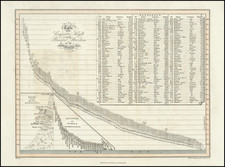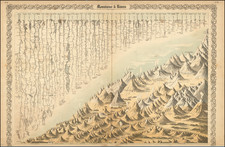History of the Holy Roman Empire
Engraved genealogy of notable Holy Roman Emperors, starting with Charlemagne and ending with Saint Cunigunde of Luxembourg. The genealogy is stylized like a flowering vine with each crowned head having their coat of arms and portrait depicted next to their title.
Charlemagne, the first Holy Roman emperor, is prominently shown at the bottom left of the page at the base of the stem. His wife, Hildegard, is pictured as well with her being the symbolic gardener for the family tree as she holds the vine that connects to everyone else.
The vine continues with brothers Lious the German and Charles the Bald who share an equal position. The choice to include these men underscores their importance for the history of the empire as both men waged a brutal war for control over the empire following the death of their father Louis the Pious. Eventually, the brothers split the realm and brought peace to the land, hence their inclusion in this genealogy.
The figure at the top left is interesting as it is Cunigunde (Kunigunde) of Luxembourg, a canonized saint and one of the few empresses of the Holy Roman Empire. Cunigunde came to power in the 11th century and dedicated much of her rule to charitable acts. During her reign, Cunigunde routinely donated alms to the poor as well as sponsored the creation of Kaufungen Abbey. These pious actions earned Cunigunde a sainthood in the Catholic Church so her prominent location is understandable.
From Hartmann Schedel's famous 1493 publication Nuremberg Chronicle (Liber Chronicarum). One sheet, printed verso-recto with the back sheet being a dancing scene called Basse danse (Low dance). A brief description of both sheets can be found here.
Hartmann Schedel (1440-1514) was a physician, book collector, and writer whose most famous work, the Liber Chronicarum (Nuremberg Chronicle), included some of the first printed views of many cities in Europe and across the world.
Schedel was born and died in Nuremberg, but he also traveled for his education. From 1456 to 1463 he lived in Leipzig, where he attended the University of Leipzig and earned his MA. From there he went to Padua, where he earned a Doctor of Medicine in 1466. After university, he worked for a time in Nördlingen and then returned to Nuremberg. In 1482 he was elected a member of the Great Council of Nuremberg.
The Chronicle was published in 1493. Besides this major work, one of Schedel’s most enduring legacies is his magnificent manuscript and printed book collection, one of the largest of the fifteenth century. In 1552, Schedel's grandson, Melchior Schedel, sold about 370 manuscripts and 600 printed works from Hartmann Schedel's library to Johann Jakob Fugger. Fugger later sold his library to Duke Albert V of Bavaria in 1571. This library is now mostly preserved in the Bayerische Staasbibliothek in Munich.
Among the surviving portions of Schedel's library are the records for the publication of the Chronicle, including Schedel's contract with Anton Koberger for the publication of the work and the financing of the work by Sebald Schreyer and Sebastian Kammermeister, as well as the contracts with Wohlgemut and Pleydenwurff for the original artworks and engravings. The collection also includes original manuscript copies of the work in Latin and German.









![[ American Antiquarian Society Membership Certificate -- Charles Lucien Bonaparte, Prince of Canino and Musignano ] Olim Meminisse Juvabit](https://storage.googleapis.com/raremaps/img/small/84482.jpg)

![[ Temperance Allegorical View ] Black Valley Railroad. Tickets Sold at all Liquor Shops. Accidents by Collisions are Entirely Avoided, as no up Trains are Run Over the Road.](https://storage.googleapis.com/raremaps/img/small/101469.jpg)
![(Mississippi Bubble) De Lachende Ezopus op het koolmaal gehouden ter afscheyd van de Actieapen [The Laughing Aesop held at the cabbage feast as a farewell to the Action Monkeys.]](https://storage.googleapis.com/raremaps/img/small/94492.jpg)

